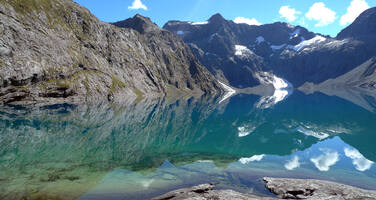Te Wahipounamu – South West New Zealand
Factors affecting the property in 2000*
- Invasive/alien terrestrial species
Factors* affecting the property identified in previous reports
- Hydro-electric scheme (issue resolved)
- Exportation of fresh water project
- Cattle grazing
- Potential logging
- Land ownership
- Introduced Himalayan thar
International Assistance: requests for the property until 2000
Total amount approved : 0 USD
Missions to the property until 2000**
Information presented to the Bureau of the World Heritage Committee in 2000
Previous deliberations:
Twenty-third session of the Committee – paragraph X.28 and Annex VIII
New information: The Centre has not yet received the detailed report on the management of the introduced mountain “thar” the State Party was requested to submit before 15 April 2000.
Action Required
Conservation issues presented to the World Heritage Committee in 2000
As requested by the last two sessions of the Bureau, the Department of Conservation of New Zealand has supplied a report on the management of Himalayan Thar in this site. This report outlines the Department’s commitment to the World Heritage Convention and the high priority it places on protecting the conservation values of the Te Wahipounamu World Heritage area. The Himalayan Thar Management Policy covers the management of Thar throughout New Zealand. The report points out that “the policy intentions of the New Zealand Government are clearly directed at sustained control of thar for the maintenance of an ecologically acceptable, vegetation and estate condition”. At present a Himalayan Thar Control Plan is in place as a tool for implementing the Policy and the total number of thar has been reduced from more than 13,000 to less than 7,000 in just five years. The Department notes its commitment to a scientifically robust monitoring programme to measure the impacts of thar on vegetation and it is expected to report on these results in 2002/3.
Following this report from the State Party, IUCN consulted with the Forest and Bird Society (FBS) who raised concerns over this issue with the World Heritage Centre and with the New Zealand Conservation Authority. FBS is pleased that the State Party has acted on the concerns raised and that progress is being made. However, the possibility of the World Heritage area being re-infested by thar populations from outside the area continues to be a cause for concern and requires further consideration. The New Zealand Conservation Authority (NZCA), which has a statutory role under the National Parks Act has expressed some dissent on the overall Thar Management Policy:
· NZCA claims that “(T)he Policy is misguided. A concerted effort over a few years is required as opposed to selective culling and monitoring over many years. The Authority believes such an investment would be cost effective in both commercial and conservation terms.”
· The NZCA requested in 1998 that a review of the Policy be carried out in 2000. It believes that “monitoring the Plan is not likely to yield any information that will persuade either the recreational hunters or those concerned with the ecology of the conservation estate to change their views.”
· NZCA recognises that “any decision will be a political one as consensus will never be reached among the deeply divided interests in this matter. The Authority remains of the view that the Policy and Plan are inconsistent with the legislative framework for the management of public conservation lands.”
Summary of the interventions
Decisions adopted by the Committee in 2000
24 BUR IV.B.33
Te Wahipounamu – South West New Zealand (New Zealand)
The Centre informed the Bureau that it had not received the detailed report on the management of the introduced mountain “thar” the State Party was requested to submit before 15 April 2000. The Delegate of Australia commented that according to his information the document was submitted to the Centre.
The Bureau requested the Centre to contact the State Party to obtain the detailed report on the management of the introduced mountain thar by 15 September 2000.
24 COM VIII.iii
State of conservation reports of natural properties noted by the Committee
State of conservation reports of natural properties noted by the Committee
Belovezhskaya Pushcha/Bialowieza Forest (Belarus/Poland)
Pirin National Park (Bulgaria)
Dja Faunal Reserve (Cameroon)
Gros Morne National Park (Canada)
Canadian Rocky Mountains Parks (Canada)
Comoe National Park (Côte d'Ivoire)
Galapagos Islands (Ecuador)
Komodo National Park (Indonesia)
Lorenz National Park (Indonesia)
Mount Kenya National Park/Natural Forest (Kenya)
Te Wahipounamu - South West New Zealand (New Zealand)
Arabian Oryx Sanctuary (Oman)
Huascarán National Park (Peru)
Danube Delta (Romania)
Lake Baikal (Russian Federation)
Niokolo-Koba National Park (Senegal)
Doñana National Park (Spain)
Sinharaja Forest Reserve (Sri Lanka)
Bwindi Impenetrable Forest (Uganda)
Gough Island (United Kingdom)
Ngorongoro Conservation Area and the Serengeti National Park (United Republic of Tanzania)
Ha Long Bay (Vietnam)
Mosi-oa-Tunya/Victoria Falls (Zambia/Zimbabwe)
The Bureau may wish to adopt the following and transmit it to the Committee for noting:
“The Bureau notes that the State Party is in the process of implementing a Himalayan Thar Control Policy but invites the State Party to take into consideration the criticisms of NZCA concerning selected aspects of the Policy. The Bureau requests that the State Party give due consideration to changes called for by the NZCA when it reviews the Policy’s impacts during 2002/2003, or if possible, earlier. The Bureau invites the State Party to submit a progress report on the implementation of the Policy and its plan or efforts to undertake a review of policy implementation to the next extraordinary session of the Bureau in 2001.”
Exports
* :
The threats indicated are listed in alphabetical order; their order does not constitute a classification according to the importance of their impact on the property.
Furthermore, they are presented irrespective of the type of threat faced by the property, i.e. with specific and proven imminent danger (“ascertained danger”) or with threats which could have deleterious effects on the property’s Outstanding Universal Value (“potential danger”).
** : All mission reports are not always available electronically.


